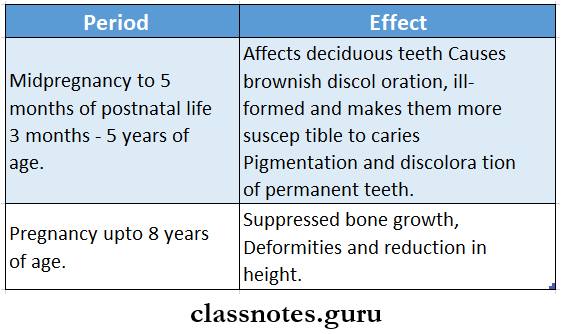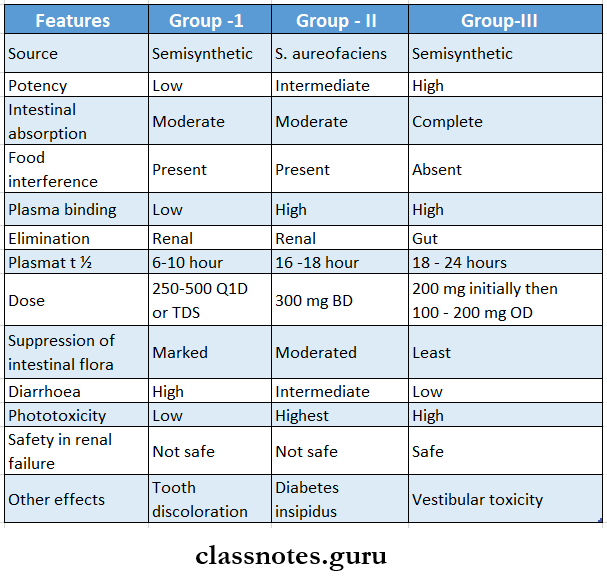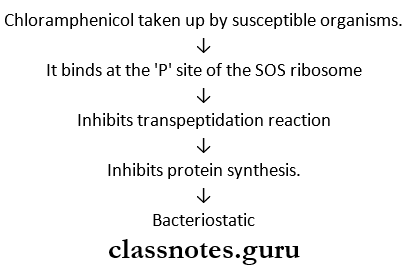Broad-Spectrum Antibiotics Important Notes
1. Tetracyclines
- The first isolated tetracycline is chlortetracycline
- They are bacteriostatic
- Have a broad spectrum of action
- Effective against bacterial, rickettsial, and chlamydial infections
- Forms insoluble complexes by chelation with calcium. Magnesium and aluminum
- Widely used in the treatment of periodontal diseases
- It interferes with the bacteriocidal activity of penicillin
- Thus it is not given along with penicillin
- It potentiates the anticoagulant action of coumarin drugs
- Has enterohepatic circulation
- Excreted by kidneys except for chlortetracycline
- Tetracyclines Classification
- Group I – tetracycline, Chlortetracycline, Oxytetracycline
- Group II – Demeclocycline, methacycline
- Group III – Doxycycline, Minocycline
Read And Learn More: Pharmacology Question and Answers
- Tetracyclines Adverse effects
- Photosensitivity
- Hepatotoxicity
- Renal toxicity
- Bone marrow suppression
- Super infections
- Hepatic dysfunction
- Fanconi like syndrome
- Tetracyclines given to pregnant women cause
- Discoloration of teeth in the fetus
- Temporary suppression of bone growth
- Hepatic necrosis in mother
- Increased intracranial pressure in infants.
Broad-spectrum antibiotics examples
2. Chloramphenicol
- It inhibits the protein synthesis of bacteria
- In high concentrations, it inhibits the protein synthesis of the host
- It is the drug of choice for typhoid
- Chloramphenicol Adverse effects
- Bone marrow depression
- Gray baby syndrome in infants
- Idiosyncrasy
- Superinfection
3. Advantages of doxycycline over tetracyclines
- Has longer half-life
- Less propensity to cause GI disturbances
- Better GI absorption
- High lipid solubility
4. Local drug delivery systems of tetracyclines
- Activity – 25% tetracycline
- Atridox – 10% doxycycline
Broad Spectrum Antibiotics Long Essays
Question 1. Explain broad-spectrum antibiotics. Describe the mechanism of action, therapeutic uses, and toxic effects of tetracyclines.
Answer:
Broad-spectrum antibiotics:
- Broad-spectrum antibiotics are effective against a large number of microorganisms except for fungi and viruses.
- They are bacteriostatic and bacteriocides
- They are:
- Tetracycline.
- Chloramphenicol.
Tetracyclines:
- Obtained from soil actinomycetes.
- They are slightly water soluble.
Tetracyclines Anti-bacterial spectrum:
- Tetracyclines are broad-spectrum antibiotics.
- They are effective against gram-positive and gram-negative organisms.
- Also inhibit the growth of Rickettsiae, chlamydia, mycoplasma, and some protozoa.
Tetracyclines Classification:
1. Group-1 short-acting: Tetracycline, oxytetracycline.
2. Group- II – intermediate-acting: Demeclocycline, methacycline.
3. Group- III – long-acting: Doxycycline, minocycline.
Tetracyclines Mechanism of action:

Tetracyclines Therapeutic uses:
1. Orodental condition
- Tetracycline – 250 mg QID is used as an adjuvant for chronic periodontitis.
- Doxycycline – 0.1 – 0.2 g/day for 2 – 4 weeks controls gingival inflammation.
- Doxycycline polymer gel is placed in the periodontal pockets.
- Appropriate surgical treatment combined with 2 – 4 week tetracycline therapy stops the progression of juvenile periodontitis.
2. General uses
Used for initial treatment of mixed infections.
- First choice of drug for:
- Chlamydial infections.
- Lymphogranuloma venerum – given for 2 weeks.
- Trachoma – given topically.
- Inclusion conjunctivitis.
- Rickettsial infections – typhus, Q. Fever.
- Atypical pneumonia.
- Cholera – reduces stool volume.
- Brucellosis – combined with gentamicin.
- Plague – combined with aminoglycoside.
- Replacing fever.
- Second choice of the drug too.
- Penicillin for tetanus, anthrax.
- Ciprofloxacin for gonorrhea
- Ceftriaxone for syphilis.
- Azithromycin for trachoma.
- Chlamydial infections.
3. Other uses
- Urinary tract infections.
- Traveler’s diarrhea.
- Acne.
- Protozoal infections – amoebiasis, malaria.
- Chronic obstructive lung disease prophylactic use.
- Inappropriate secretion of ADH – demeclocycline is used.
- Topical use in scaling and root planning procedures.
Tetracyclines Adverse effects:
1. Irritative effects:
- GIT effects
- Causes nausea, vomiting, epigastric pain, and diarrhea.
- Esophageal ulceration occurs.
- Local effects
- Pain at the site of injection.
- Thrombophlebitis on IV injection.
2. Dose-related toxicity
- Hepatotoxicity
- Resulting in jaundice.
- Causes acute hepatic necrosis in pregnancy.
- Renal toxicity
- Tetracyclines accumulate and enhance renal failure.
- Occurs due to the degradation of products which damages proximal renal tables.
- Phototoxicity
Skin reactions and dermatitis occur due to sun exposure.
- Effect of Teeth and Bones
Tetracyclines have chelating properties.

- Antianabolic effect
- Reduces protein synthesis.
- Induces negative nitrogen balance and increases blood urea.
- Increases intracranial pressure
- Diabetes insipidus.
- Vestibular toxicity.
3. Hypersensitivity reactions
Skin rashes, urticaria, glossitis, pruritus, exfoliative dermatitis occurs.
4. Superinfections
Tetracyclines suppress normal flora and cause superinfections.
Question 2. How will you treat a case of superinfection due to tetracycline therapy?
Answer:
Tetracycline:
It is a broad-spectrum antibiotic.
Tetracycline Superinfection:
- It refers to the appearance of a new infection as a result of antimicrobial therapy.
- The use of tetracyclines alters the normal microbial flora of the body.
- Due to it, non-pathogenic components of the flora like Candida predominates and invades the flora.
- The mouth, skin, vagina, and intestinal are invaded by Candida albicans.
- It leads to pseudomembranous enterocolitis.
Superinfection Treatment:
- Tetracycline is discontinued.
- To treat superinfection antifungal agents like nystatin or clotrimazole are used.
Uses of broad-spectrum antibiotics
Question 3. List four tetracyclines. Explain pharmacokinetic differences among tetracyclines.
Answer:
Tetracyclines:
1. Group I – short-acting: Tetracycline, oxytetracycline.
2. Group II – intermediate-acting: Demeclocycline, methcycline.
3. Group III – long-acting: Doxycycline, minocycline.
Differences among tetracyclines:

Question 4. Explain the adverse effects of Tetracyclines. Add a note on Doxycycline.
Answer:
Adverse Effects Of Tetracyclines:
1. Irritative effects
- GIT effects
- Nausea, vomiting, epigastric pain, diarrhea
- Local effects
- Pain at the site of injection
- Thrombophlebitis on IV injection
2. Dose-related toxicity
- Hepato toxicity
- Results in jaundice
- Causes acute hepatic necrosis in pregnancy
- Renal toxicity
- Tetracyclines accumulate and enhance renal failure
- Occurs due to degradation of products which damages proximal renal tubules
- Phototoxicity
Skin reactions and dermatitis occurs due to sun exposure
- Effect on teeth and bones
Tetracyclines have chelating property

- Antianabolk effect
- Reduces protein synthesis
- Increases blood urea
- Increases intracranial pressure
- Diabetes insipidus
- Vestibular toxicity
Broad-spectrum antibiotics classification
3. Hypersensitivity reactions
Skin rashes, urticaria, glossitis, pruritis, exfoliative dermatitis
4. Superinfection
Tetracyclines suppress normal flora and cause superinfection
Doxycycline:
- It is a semi-synthetic tetracycline
- When given orally it is 95% absorbed
- Food does not interfere with its absorption
- The plasma half-life is 18-24 hours
- So it is given once a day
- It is primarily excreted in feces as conjugate
- Phototoxicity, less renal toxicity occurs
Broad Spectrum Antibiotics Short Essays
Question 1. Give reasons for not prescribing tetracycline to a child of 5 – years.
Answer:
Tetracyclines have chelating properties
- It chelates calcium.
- Calcium-tetracycline chelate gets deposited in developing teeth and bone.
- The deformities depend on the time of tetracycline administration.
1. Mid-pregnancy up to 5 months of postnatal life
- Deciduous teeth are affected.
- Causes brownish discoloration.
- Teeth become ill-formed and more susceptible to caries.
2. 2 months – 5 years of age
- Effects permanent dentition.
- Causes discoloration of teeth.
- Permanent interiors are commonly affected.
- A repeated course is more damaging.
3. Pregnancy and childhood up to 8 years
- Causes temporary suppression of bone growth.
- Prolonged use of tetracyclines leads to bone deformities and height reduction.
Broad vs narrow-spectrum antibiotics
Question 2. Chloramphenicol.
Answer:
Chloramphenicol is a broad-spectrum antibiotic.
It is obtained from streptomyces venezuelae in 1947.
Chloramphenicol Mechanism of Action:

Chloramphenicol Uses:
1. Typhoid fever
- Given for 14 days.
- Initially – 500 mg QID till the fever subsides.
- Later – 250 mg QID up to the 14th day.
2. Meningitis
Used as an alternative to penicillin.
3. Anaerobic infections
Used in combination with penicillin and aminoglycosides.
4. Eye infections
Used for endophthalmitis.
5. Topical use
Used in conjunctivitis, external ear infections.
6. Second drug of choice to
- Tetracycline for brucellosis, and cholera.
- Erythromycin for whooping cough.
- Penicillin for meningococcal infections.
- Cotrimoxazole for dysentery.
- Fluoroquinolones for UTI.
Chloramphenicol Adverse Effects:
1. Bone marrow depression.
Occurs in 2 ways.
- Non-dose-related idiosyncratic reaction
- Rare but serious.
- Manifested as aplastic anemia.
- Dose-dependent reaction
- Occurs due to the inhibition of mitochondrial enzyme synthesis.
- Characterized by anemia, leukopenia, and thrombocytopenia.
2. Hypersensitivity reactions
Rashes, fever, atrophic glossitis, angioedema.
3. Irritative effects
- GIT disturbances – Nausea, Vomiting, diarrhea.
- Pain on injection.
4. Superinfection.
5. Grey baby syndrome
- Occurs when high doses are given.
- Baby develops vomiting, refusal of feeds, hypotonic, hypothermia, abdominal distension, irregular respiration, and ashen grey cyanosis.
Broad Spectrum Antibiotics Short Question And Answers
Question 1. Adverse effects of broad-spectrum antibiotics.
Answer:
1. Toxicity
- Local irritancy
- Broad-spectrum antibiotics act as irritants and causes.
- GIT disturbances – nausea, vomiting.
- Pain at the site of injection.
- Broad-spectrum antibiotics act as irritants and causes.
- Systemic toxicity
- They affect organs.
- Tetracyclines cause phototoxicity, hepatotoxicity, and renal toxicity.
- Chloramphenicol causes bone marrow suppression.
- They affect organs.
2. Superinfection
- The use of broad-spectrum antibiotics leads to the alteration of the normal microbial flora of the body.
- Due to it, even non-pathogenic organisms present invade the flora.
- As a result, a new infection occurs.
Antibiotic classification chart
Question 2. Doxycycline.
Answer:
Doxycycline is semi-synthetic tetracycline.
- When given orally, it is 95% absorbed.
- Food does not interfere with its absorption.
- The plasma half-life is 18 – 24 hours.
- So, it is given once in a day.
- It is primarily excreted in feces as conjugate.
- Phototoxicity, less renal toxicity occurs.
Question 3. Tetracyclines should not be given with antacids.
Answer:
Tetracyclines have chelating properties.
- They form insoluble and unabsorbable complexes with calcium and other metals.
- Milk, iron preparations, non-systemic antacids, and sucralfate reduces their absorption.
- Hence tetracyclines should not be given with antacids.
